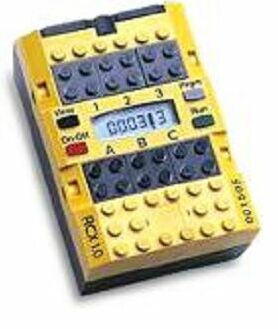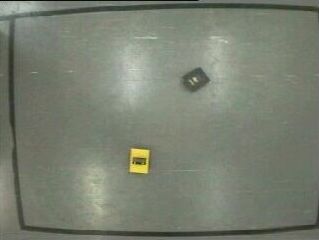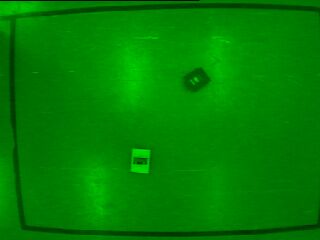Vision based pursuing of moving vehicle from bird's view - PART I
(LEGO Lab) |
by Adir Hacohen & Yonatan Cohen
Supervised by Shie Manor |
Abstract
Our system performs pursuit of a vehicle by another ('catching' and 'target' vehicle).
The information about the vehicles' locations is received from a ceiling camera that oversees the entire "playground".
A controlling computer tracks the movement of both vehicles and controlls the movement of the 'catching' vehicle.
Working environment
- 2 'LEGO Mindstorm' vehicles controlled by RCX brick + IR transmitter attached to a PC.
- Ceiling mounted dome camera (WATEC 207-CD)
- PC + video card. (Pentium 4 & ASUS Geforce V7700/64 VIVO graphics card)
- The software (self developed) is implemented in C++ and contains two processes LegoCatch and CamCapture that exchange information. The code is flexible for addition of more vehicles / obstacles in the future.
CamCapture is based on a code example found on the internet which captures from cameras which support the Microsoift Video for Windows standard. (For reference search www.codeguru.com for AVICap).
LegoCatch is based on the Lego Mindstorms Visual C++ Win32 Interface by Daniel Berger (link). The interface enables to send controlls for the RCX through the IR channel using the IR transmitter of 'LEGO Mindstorms Robot Invention Kit version 1.5' (it does not support the USB based new versions).
 |
 |
| Figure 1 The Catcher (yellow) and the target (black), |
Figure 2 The RCX unit |
The algorithm
The implemented algorithm has 3 phases:
1. Picture sampling
2. Recognition of the vehicles
3. Movement control
1. Sampling
CamCapture samples the pictures in 16 bit RGB format using 320*220 resolution.
LegoCatch performs the analysis of the captured pictures and translates visual information to controll commands for the RCX.
On each iteration LegoCatch notifies CamCapture and receives a captured image.
The image is then transformed by LegoCatch to a green image with 128 shades (the captured image is RGB but we found that using only the green color gives good enough results).
The first capture is taken when the playground is empty. This is used as a reference image. Each new captured image is subtracted from the reference image and the difference image used as input to the algorithm.
This method is used in order to work with a unic background (e.g. in the figure you can see that the light reflections are eliminated) and also to avoid changes in the background caused by changing light conditions etc..
 |
| Figure 3 Captured image as received by CamCapture |
 |
 |
| Figure 4 Green component image |
Figure 5 Difference image |
2. Recognition of the vehicles
In order to recognize the two vehicles we have to distinguish them from the background and from each other.
The recognition is done as follows:
I)
We scan the matrix pixel by pixel.
for each pixel if |pixel value| Each node will hold the pixel value & its location (x,y).
Now we have a list of the pixels that are suspected as part of an object.
II )
We move a pixel (a) from the list to another list. then We scan the first list for neighbour pixels of (a).
If neighbors are found we will move them to the second list and look for their neighbours.
When there are no more neighbors in the first list and the first list still contains pixels we start another list.
We repeat this phase until there are no more pixels in the original list.
We eliminate lists that hold less than 20 pixels (we consider them as noise).
Now we have a list for each object on the playground.
Each list header holds:
- Number of pixels
- Average shade
- Coordinates of the center of mass (by calculating the average position of the pixels)
- Diagonals ratio (supposed to be close to 1 in symmetric objects)
Knowing the properties of each vehicle we can now decide of the position of each vehicle.
3. Movement control
The RCX block has 3 inputs and 3 outputs.
The Lego vehicle has two wheels, each wheel is connected to an engine.
Each engines is controlled by a different RCX output and has 8 speed levels.
The RCX code controls the engines speed.
We designed 3 modes of movement for the catcher:
1. Forward - the 2 engines are set to level 7 ( full speed)
2. Curve left / Curve right - one engine is set to level 1 (minimal speed) and the other is set to level 8 (full speed)
3. Spin - one engine is set to level 7 (forward) and the other is set to level -7 (reverse)
 |
| Figure6 The "naked" vehicle A,B,C are outputs and 1,2,3 are inputs |
Calculating the movement direction
 |
| Figure 7 Calculation of directions |
a : The catcher's direction is (in degrees) determined by the vector generated between the catcher's last position and its current position.
b : The target's direction is determined by the vector generated between the catcher's Current position and the target position
g : The movement direction is the difference between the two angles
g varies between -180 and 180 degrees
if 45 g| if 10 g| if |g| * comment : The first movement must be forward regardless of the target position in order to get the initial direction
The target vehicle
Built on the same platform as the catcher vehicle, controlled by an RCX which is preprogrammed to move in fixed paths that have been loaded to it's memory slots. The RCX's inputs are connected to 3 light sensors. When the sensors reach a certain threshold the vehicle stops.
Catch
When the 'catching' vehicle reaches the target the two objects unite to one big object. LegoCatch stops the Catcher and two lights located in front of the catcher are being turned on. The target sensors are exceeding the threshold and the target stops. LegoCatch sends a "CATCH" message.
 |
| Figure 8 snapshot of a catch |
| |
| |
Results
High reliability was achieved due to the fact that we used only 2 vehicles that could be easily distinguished and that the vehicles were relatively slow.
Acknowledgment
We are grateful to our project supervisor Shie Manor, the lab engineer Johanan Erez and the lab assistant Dror Ozana. We would also like to express our gratitude to the Ollendorf Research Center Fund for supporting this project.
|








